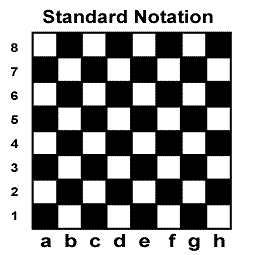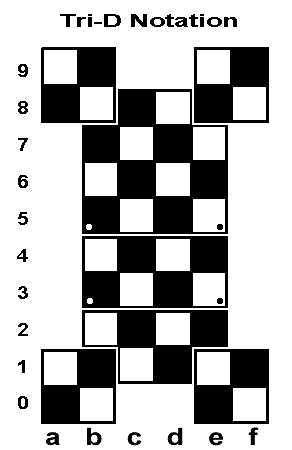|

|
| I was just a kid, a hard-core
Trekkie, back in 1976 when Ballentine Books published the original TOS
Starfleet
Technical Manual. At last, the authorized Paramount version of true
Trek hardware! I thumbed through that book, almost drooling. And there
it was...the original TOS Tri-D chessboard! There lay the original thing:
the four "attack boards", positioned above and below the main boards; the
starting positions of the game pieces; some simple suggestions about gameplay...but
no real "rules." You could dream about playing, but never really play.
Something had to be done.
I wrote Franz Joseph Schnaubelt, the book's writer and editor, and he encouraged me to work at the rules on my own, to develop them into something playable: ST3d.
My promise: for any registered user, if you have a problem understanding them, email me at wizard@yestercade.net and I will try and help you. If I cannot, and you are still confused, I will mail you your money back. Here follows some bits and pieces about the game, to fairly show you that my rules are a worthwhile product. I hope they will whet your appetite for the full game. The Federation Standard Rules come in a neat, well-illustrated 5-1/2" x 8-1/2" booklet, with a sharp electric blue 60# stock cover. They include fully detailed construction plans for your own full-size TOS gameboard, and definitive, specific rules about the more elaborate six-attack board version of the game as well. The FS5.0 set includes also the Klingon, Cardassian, and Ferengi variations of the game as well. To learn more about buying the Rules, click this link. I am no Grand Master of the game, and all living things evolve, so feel free to email comments and suggestions about improving gameplay. You may be helping to mold the future of the game! That said, here are some basics for this version of Tri-D Chess. Hope you enjoy playing! Back to the FutureWhile researching ways to make the game of Tri-D Chess easier and more accessible, it became clear that notation is one of the major stumbling blocks to the spread of the game. Do we use the original move notation I created 20 years ago? Sadly, I only used that "Queen to Queen's Level three" nonsense to tie into the original TV series canon; the notation is clunky and hard to understand. Should we use the revised notation I adopted for the 1992 revision 3.1 Tri-D Chess rules? Better, but that system still falls short of tracking the pieces in a 3D environment. Clearly, a clean and effective system is needed, so I turned to the current international standard for inspiration.Algebraic Notation Conventional flat-board chess may be described through "algebraic notation":
the newer international system which defines any chess board in one standard
number-and-letter grid. The files (across) are designated by the lower-case
letters of "a" through "h", while the ranks are numbered 1 through 8. Board
illustrations are always shown from White's side of the board, and the
numbering is not reversed to describe Black's moves. Each square has only
one name ("a3" or "b6" would be examples.)
Conventional flat-board chess may be described through "algebraic notation":
the newer international system which defines any chess board in one standard
number-and-letter grid. The files (across) are designated by the lower-case
letters of "a" through "h", while the ranks are numbered 1 through 8. Board
illustrations are always shown from White's side of the board, and the
numbering is not reversed to describe Black's moves. Each square has only
one name ("a3" or "b6" would be examples.)
While the squares are defined with lower-case letters, the pieces are listed in upper-case, as "K" for King, and "N" for Knight. You can see that on a standard chess board, the White King would begin the game on e1, while the Black Queen would be at d8. All moves become easier to trace, because we maintain one notation system which does not change perspective from move to move. The Federation Tri-D Chess Board The Tri-D board requires a unique extension of the standard algebraic board
layout. For our game, the main board is designated in files "b" through
"e", and standard ranks 1 through 8.
The Tri-D board requires a unique extension of the standard algebraic board
layout. For our game, the main board is designated in files "b" through
"e", and standard ranks 1 through 8.
The attack boards further complicate the matter. Where the attack boards overlap the main board, the b-to-e and 1-to-8 matrix is used to define the move. But when the attack boards overhang the main board, we must extend the standard files to include "a" and "f", and the rank space to include 0 and 9. Thus, White Queen's Rook begins the game at a0, and the same Rook's Pawn is at a1. Also since many squares now exist on two or more levels, we must further
define each square by adding a z-notation. In the case of
a piece which moves to a square which overlaps another, we must add a number
indicating which of the many chessboards it landed on. This z-coordinate
is numbered from 1 to 7, notating the possible board levels on the gameboard.
The lowest z-number would be 1, where the chess piece would be moving to
an inverted attack board attached under White's main board. The
highest z-number would be 7, with a piece moving to an upright attack
board attached to Black's main board. Including the z-coordinate, the full
designation of the White King's starting position would be e0(3). To be sure, this is White's starting layout, and on Black's side "Queen on her own color" inverts the royal family, left to right, just as in a standard chess board. In standard algebraic chess notation, you need only write the bare minimum of information that you think you will need to explain the move; this may be as brief as "f2-d3"! However, the extra freedom enjoyed on a Tri-D board means that the best notation is full notation! Game moves use the following format: first note the name of the piece you are moving, then the starting square, then the destination square. Where more than one level exists in the same square, you must add the z-coordinate in parenthesis. In the sample game below, I add the z-coordinate in every case, for clarity. The capture of a piece or an attack board is still notated with an "x". Other "special" moves are notated as follows: Check is listed as a "+", Kingside castling is "O-O", Queenside castling is "O-O-O". Mate, Checkmate or Draw may be written out longhand. Attack BoardsThe movement of the attack boards needs some clarification, as well:
|
||
A Sample Tri-D GameFor those of you who want real answers, here is a sample game. All moves are guaranteed 100% possible by the original author.This is by no means an elegant game; I had to play both sides, and it is mainly just to illustrate how the pieces move. I have gone over this game many times to verify it, and this should be considered accurate and correct, and useful for explaining the movement of the pieces. Six Attack Boards, No WaitingThere is also a known board variation using six attack boards. You may find yourself curious as to where they begin the game, or how they move, as others have failed to document that. Here's my view on that variation:The two additional attack boards begin the game located attached to the e3(4) and the b6(4) pins, and are referred to as the "Neutral Levels" (or NL's). They start the game as unclaimed fixed Levels, and cannot be moved by either side. The first player to move a chess piece onto either board takes possession of that attack board, gaining control of it as an attack craft, and this changes the Level's designation to a "White Level" (WL), or "Black Level>" (BL), respectively. Note that the close proximity of these Neutral Levels to each side's King's Level means that the logical move is to strike out immediately with a Pawn, and claim the Level early in the game. The Neutral Level may also be claimed with a more powerful piece than a Pawn, but as usual, it can only be moved when occupied by a Pawn or less. Do watch your additional Levels carefully, however, as they are just as easily hijacked from your control should your opponent take your last piece off the Level. |
|
|
Pushing the Warp Envelope Some
bright young gamer has founded the 3-D
Chess Federation, a meeting place for all the various versions of three-dimensional
chess: the ST3d (or "Federation Board"), 4x4x4, 4x4x8, 8x8x3, 5x5x5, and
others. The group offers a list-serv mailing list of Tri-D information,
and can even set you up to get a "digest" mailing of current Tri-D gaming
thought. Hop the link to check out their homepage and learn more. Some
bright young gamer has founded the 3-D
Chess Federation, a meeting place for all the various versions of three-dimensional
chess: the ST3d (or "Federation Board"), 4x4x4, 4x4x8, 8x8x3, 5x5x5, and
others. The group offers a list-serv mailing list of Tri-D information,
and can even set you up to get a "digest" mailing of current Tri-D gaming
thought. Hop the link to check out their homepage and learn more.
|
||
|
Last Revision on 01-16-19 (Old Earth) © 2019, Andrew Bartmess URL: http://www.yestercade.net/index.htm |
|